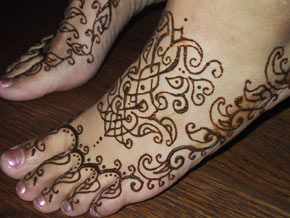Indian Wedding Henna
Wedding is an elaborate affair in India, comprising of a large number of rituals, customs and traditions. One of the important rituals, especially in context of the bride, comprises of 'Mehndi' (commonly known as henna). As a part of this ritual, the powder of henna leaves is mixed with water (and many-a-times, oil and lemon juice as well), to form a paste. This paste is then applied on the hands as well as the feet of the bride, in the form of intricate patterns. The henna is removed only after the design dries off completely. In fact, it is said that the darker the color of the mehendi (on the hands and the feet of a bride), the stronger will be the marriage and longer it will last. At the same time, the dark color of henna is also said to mean that the bride will receive a lot of love from her husband as well as her in-laws. This is the reason why, after the application of bridal henna designs, the bride undertakes a lot of efforts, like applying oil or heat, to ensure that the color is dark.. Baraat is the term used to denote the procession of the groom, including all his family members, relatives and friends, before he arrives at the wedding venue. 'Doli' signifies the end of a wedding ceremony, when the bride goes away with her husband. Both of these designs are extremely intricate and involve long hours of labor. Apart from that, the common bridal mehendi designs include peacock, kalash, flowers, leaves and conch-shells. Whatever be the design, drawing images of the bride and groom, as well writing the groom's name, on bride's hands, is compulsory.
Wedding is an elaborate affair in India, comprising of a large number of rituals, customs and traditions. One of the important rituals, especially in context of the bride, comprises of 'Mehndi' (commonly known as henna). As a part of this ritual, the powder of henna leaves is mixed with water (and many-a-times, oil and lemon juice as well), to form a paste. This paste is then applied on the hands as well as the feet of the bride, in the form of intricate patterns. The henna is removed only after the design dries off completely. In fact, it is said that the darker the color of the mehendi (on the hands and the feet of a bride), the stronger will be the marriage and longer it will last. At the same time, the dark color of henna is also said to mean that the bride will receive a lot of love from her husband as well as her in-laws. This is the reason why, after the application of bridal henna designs, the bride undertakes a lot of efforts, like applying oil or heat, to ensure that the color is dark.. Baraat is the term used to denote the procession of the groom, including all his family members, relatives and friends, before he arrives at the wedding venue. 'Doli' signifies the end of a wedding ceremony, when the bride goes away with her husband. Both of these designs are extremely intricate and involve long hours of labor. Apart from that, the common bridal mehendi designs include peacock, kalash, flowers, leaves and conch-shells. Whatever be the design, drawing images of the bride and groom, as well writing the groom's name, on bride's hands, is compulsory.














No comments:
Post a Comment